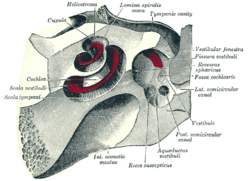
Large vestibular aqueduct
Encyclopedia

Syndrome
In medicine and psychology, a syndrome is the association of several clinically recognizable features, signs , symptoms , phenomena or characteristics that often occur together, so that the presence of one or more features alerts the physician to the possible presence of the others...
form of hearing loss, caused by enlargement of the vestibular aqueduct
Vestibular aqueduct
At the hinder part of the medial wall of the vestibule is the orifice of the vestibular aqueduct, which extends to the posterior surface of the petrous portion of the temporal bone....
, in the inner ear
Inner ear
The inner ear is the innermost part of the vertebrate ear. In mammals, it consists of the bony labyrinth, a hollow cavity in the temporal bone of the skull with a system of passages comprising two main functional parts:...
. It is one of the most common inner ear deformities which results in hearing loss during childhood.
Pathology
The vestibular aqueduct acts as a canal between the inner ear and the cranial cavity. Running through it is a tube called the endolymphatic ductEndolymphatic duct
From the posterior wall of the saccule a canal, the endolymphatic duct, is given off; this duct is joined by the ductus utriculosaccularis, and then passes along the aquaeductus vestibuli and ends in a blind pouch on the posterior surface of the petrous portion of the temporal bone, where it is in...
, which normally carries a fluid called endolymph from the inner ear to the endolymphatic sac in the cranial cavity. When the endolymphatic duct and sac are larger than normal, however, as is the case in large vestibular aqueduct syndrome, endolymph is allowed to travel back from the endolympathic sac into the inner ear. This often results from abnormal or delayed development of the inner ear during childhood. Enlarged vestibular aqueduct syndrome is often comorbid with other inner ear development problems, such as cochlea
Cochlea
The cochlea is the auditory portion of the inner ear. It is a spiral-shaped cavity in the bony labyrinth, making 2.5 turns around its axis, the modiolus....
r deformities. Studies show that genetic defects are related to large vestibular aqueduct syndrome, and have connected the disorder specifically to a defect on chromosome 7q31.
Hearing loss caused by large vestibular aqueduct syndrome is not inevitable, although people with the syndrome are at a much higher risk of developing hearing loss than the general population.


